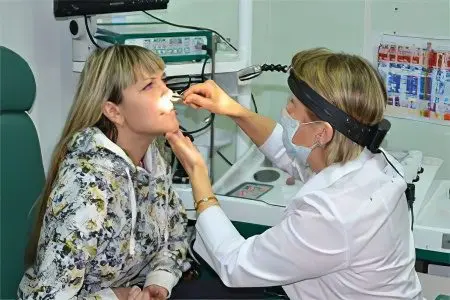Contents

Bleeding from the nose (scientifically – epistaxis) is a very common pathology in humans. With it, there is a discharge of blood from the nasal cavity, which occurs due to rupture of blood vessels. In some cases, epistaxis leads to great blood loss and even life threatening. In 20% of these bleedings, immediate medical attention is required. The nasal mucosa is distinguished by the presence of a significant number of small blood vessels. When they are damaged, blood flows out of the nostrils, but in severe cases, it can flow into the larynx and interfere with breathing. Most often, damage to the vessels is accidental when the nose is injured.
After 40-50 years, nosebleeds appear more often, because in mature people the mucous membrane is much drier and thinner than at a young age. At the same time, the ability of blood vessels to contract is reduced, and there is a tendency for the progression of arterial hypertension. In 80% of cases with unclear causes of frequently recurring nosebleeds, the patient has problems in the hemostasis system (hemostatic system).
Specialists distinguish between two types of this kind of bleeding, depending on which parts of the nasal cavity they come from:
Anterior, which occurs most often. With it, blood flows out of the nostrils;
Posterior, which is rare, but poses a significant health hazard and requires medical attention. With it, blood flows down the nasopharynx inward.
Causes of nosebleeds
This pathological condition is caused by various reasons, however, there are two groups of factors leading to nosebleeds.
Local injuries that are the most common cause of nosebleeds:
Injury to the nose during sports or an accident;
Surgery, such as rhinoplasty;
Intervention of foreign objects, including the finger;
Diseases: allergic and atrophic rhinitis, sinusitis, sinusitis. With such pathologies, the blood vessels of the nose become unprotected and more often damaged, especially if the mucous membrane is regularly dried out with nasal preparations;
Anatomical deformation of the nasal cavity;
Ulceration in the area of the choroid plexus of Kisselbach;
Taking drugs by inhaling them through the nose;
Tumors in the nasal cavity or paranasal sinuses: nasopharyngeal carcinoma, bleeding polyp;
Reduced air humidity (especially in winter), leading to overdrying of the nasal mucosa;
Barotrauma;
Use of an oxygen catheter.
Systemic causes that are less common but require the close attention of a doctor:
Allergy;
Various infectious diseases: acute respiratory infections, acute respiratory viral infections, influenza, diphtheria, sepsis, accompanied by intoxication of the body. Toxins, viruses, and bacteria cause blood vessels to dilate, becoming thin and brittle. Against the background of infections, there is a weakening of the processes of blood clotting and an increase in the permeability of its elements;
Arterial hypertension (high blood pressure);
Vascular diseases, including atherosclerosis;
Heart failure;
Increased intracranial pressure;
Blood diseases: leukemia, capillary toxicosis, hemoblastosis, anemia, hemophilia, hemorrhagic vasculitis, Randu-Osler, Werlhof, Willebrand diseases;
Lack of vitamins K, C in the body;
Pathological conditions of the liver: hepatitis and cirrhosis, which lead to a decrease in the synthesis of components that affect the normal functioning of the hemostatic system. This changes the structure of the liver tissue, which causes a slowdown in blood flow and an increase in blood pressure in those vessels that are responsible for renal circulation;
Abuse of alcoholic beverages that cause vasodilation;
Angiofibroma, which is a formation localized in the nasopharynx or at the base of the skull. It is characterized by frequent nosebleeds;
Kidney diseases that provoke an increase in blood pressure;
Hypothyroidism, which is expressed in dysfunction of the thyroid gland, in which the production of platelets is reduced;
Side effects of drugs.

In 90-95% of cases of epistaxis, its source is the anteroinferior part of the nasal septum, called the Kisselbach plexus. In other cases, bleeding develops in the middle and posterior parts of the nasal cavity. The most threatening are epistaxis, characterized by a sudden onset, large blood loss and short duration. Experts call them “signal” epistaxis. They can be caused by damage to a large vessel in the nasal cavity or a ruptured aneurysm. Nosebleeds can also be caused by cancer.
Pulmonary bleeding, which is characterized by the appearance of scarlet foamy blood, can also occur through the nose. With bleeding that occurs in the upper gastrointestinal tract, dark clotted blood may come out of the nose. Blood diseases and treatment with anticoagulants often cause this pathological condition and increase its duration. Epistaxis is also one of the signs of a skull fracture. Often, white blotches of cerebrospinal fluid are observed in the blood. Heat stroke or sunstroke can also cause nosebleeds. At the same time, it is accompanied by headache, dizziness, nausea, fainting. Even healthy people can be affected by this condition.
In cases where the exact cause of epistaxis has not been established, it is usually associated with blood diseases. Moreover, it can be a number of serious diseases. These include violations of the function and structure of platelets, a decrease in blood clotting factors and a decrease in the level of prothrombin. The reasons leading to nosebleeds also include great physical exertion, fast running, overheating of the body, sharp bends and standing up at high pressure, rarefaction of the surrounding air.
To determine the cause of chronic nosebleeds, the following laboratory and hardware studies may be needed:
Blood and urine test, which will show the general state of health;
Coagulogram characterizing the work of the blood coagulation system;
Blood test for the presence of prothrombin and determination of liver pathologies ALAT, ASAT;
Electroencephalogram, reflecting the nature of the biocurrents of the brain;
Ultrasound of the head and internal organs;
An electrocardiogram indicating disorders in the work of the cardiovascular system;
Echocardiography, aimed at examining changes in the heart and its valves;
X-ray of the nasal cavity and skull;
Computed tomography of the sinuses;
Magnetic resonance imaging of the nasal sinuses and skull.
To establish a diagnosis, the patient may need an examination by the following doctors: ENT, hematologist, surgeon, neuropathologist, cardiologist, ophthalmologist.
High blood pressure nosebleed
High blood pressure is considered one of the most common causes of nosebleeds. Its first signs are:
Throbbing headache;
Prolonged tinnitus;
Nausea and general weakness.
Frequent cases of nosebleeds, accompanied by the above symptoms, indicate hypertension. In this case, the appearance of blood from the nose is a kind of compensatory process that prevents overload of the cerebral vessels. Nosebleeds that occur with arterial hypertension are characterized by a long duration. Profuse bleeding from the nose at high pressure can lead to its rapid fall, which can provoke acute heart failure (collapse).
What is the cause of frequent nosebleeds?

Frequently recurring nosebleeds are often associated with the peculiarities of the anatomical structure of the nasal cavity. The appearance of droplets or streams of blood when coughing, sneezing, runny nose or when feeling normal indicates weak walls of the vessels of the Kisselbach plexus. Such nosebleeds are almost always observed from an early age.
Another cause of frequent spontaneous bleeding from the nose is atrophic rhinitis. With this disease, the nasal mucosa becomes thin and parched. This state of it contributes to the violation of the integrity of blood vessels at the slightest touch.
Frequent epistaxis are noted when the hormonal background changes. They can occur during adolescence and in pregnant women. Girls from the age of 11 sometimes have bleeding from the nose. They may accompany the first menstruation for some time. During pregnancy, global hormonal, structural and functional changes occur in the body. The level of sex hormones, such as estrogens and progesterone, is greatly increased. They have a direct effect on increasing blood supply in the area of the mucous membranes. At the same time, in women with fragile vessels or a thin nasal mucosa, the risk of frequent epistaxis is significantly increased. Sometimes in pregnant women, nosebleeds indicate an increase in blood pressure, which is a sign of the development of dangerous conditions such as preeclampsia and eclampsia. Also, the occurrence of epistaxis may indicate an exacerbation of kidney and liver diseases in a pregnant woman.
Regardless of the reasons, private epistaxis are an essential reason for consulting a doctor and conducting a comprehensive diagnosis of human health.
What to do about nosebleeds?
Most people have the following characteristic sensations before the onset of nosebleeds: worsening headache, throbbing tinnitus, tickling or itching in the nose. Actions in such a pathology directly depend on the factors that caused it. The severity of pathogenesis should also be taken into account.
Experts identify the following typical signs of nosebleeds:
Discharge from the nostrils or outflow into the pharynx of scarlet blood indicates that its source is the anterior or posterior part of the nasal cavity;
The outflow of foamy blood from the nose is a sign of pathology in the lower parts of the respiratory organs, namely, in the bronchi and lungs;
Minor bleeding, characterized by the release of drops and streams of blood. As a rule, their volume does not exceed a few milliliters. It usually stops on its own and is very short-lived. To stop such epistaxis, you just need to press the wings of the nose. Most often, such a pathology is formed in the area of Kisselbach’s plexus;
Moderate bleeding that results in the loss of up to 300 ml of blood. Despite this, pathological changes in the cardiovascular system most often do not occur. It is advisable to consult a doctor to study the causes of epistaxis;
Severe blood loss (300-500 ml), causing pale skin, lowering blood pressure to 110-70 mm Hg. Art., general weakness, a significant increase in heart rate (up to 90 beats / min.), dizziness. In the most severe cases, the patient loses up to 1 liter of blood. After such blood loss, after 1-2 days, the level of hemoglobin in the blood often drops. The hematocrit number with such epistaxis is reduced to 30-35 units. Profuse nosebleeds are a serious threat to human health, so you should immediately consult a doctor.
First aid for nosebleeds

If nosebleeds occur, a person must clearly determine what he can handle on his own or with the help of loved ones, and what requires immediate medical intervention.
For nosebleeds, do the following:
Reassure the victim. To do this, he must breathe slowly and deeply. Such a step relieves emotional arousal and prevents increased heart rate and increased blood pressure, which only increase blood loss;
seat the patient in a comfortable position and lift his head without tilting it back. The head should be slightly tilted forward. When the head is thrown back, blood flows down the nasopharynx, which can cause vomiting and the ingress of blood clots into the respiratory tract, leading to a disorder in the respiratory function. A container is placed under the patient’s nose to collect the outflowing blood, which allows you to accurately determine the amount of blood loss;
Take measures to stop bleeding. To do this, the wings of the nose are pressed against the septum with the fingers of the hand. Also, the patient can carefully release the nasal cavity from the blood clots accumulated in it. Drops from a cold are instilled into the cleansed nose (Galazolin, Nazivin, Sanorin, Tizin). They have a vasoconstrictive effect. 5-6 drops of the drug are instilled into each nostril. After that, 10 drops of 3% hydrogen peroxide are instilled into the nose. A very effective method of stopping bleeding from the nose is to irrigate its cavity with cold 5% aminocaproic acid. Also for these purposes, you can use drugs such as Thromboplastin or Thrombin. The above procedures act in a complex way: the vessels are mechanically squeezed, the accumulated blood coagulates and dries up faster, creating a kind of plug, nasal drops constrict blood vessels, hydrogen peroxide and other drugs accelerate the formation of a blood clot that stops the blood;
Apply a cold compress to your nose. It can be an ice pack wrapped in a cloth or a cold towel. Every 15 minutes the compress is removed for a few minutes. Due to the effect of cold, blood vessels constrict, which quickly reduces the intensity of bleeding. Immersion of hands in cold water, and legs in warm water also contributes to a faster stop of blood;
Insert a cotton swab into the nostrilsmoistened in a solution of vasoconstrictor drugs (3% hydrogen peroxide, 5% aminocaproic acid). In this case, the wings of the nose should be pressed against the septum for 5-15 minutes. When removing the tampon, you should be extremely careful not to damage the vessels again and pull off the resulting crust;
Give the patient a drink of salted water (1 teaspoon/200 ml).
When should you see a doctor?
Sometimes first aid measures may not be enough. You should immediately consult a doctor if:
Injuries to the nose and skull;
Continuous bleeding for a long time;
Too much blood loss (up to 200 or more milliliters);
Exacerbations of chronic diseases of the kidneys and liver;
The presence of infectious diseases;
A sharp deterioration in well-being, general weakness, vomiting, pallor of the skin, dizziness, loss of consciousness.
Prevention
As a prophylaxis of epistaxis, we can recommend:
Strengthening the walls of blood vessels by regularly taking vitamin C or foods high in it;
Maintaining normal blood pressure;
Training of blood vessels with the help of a contrast shower, bath, hardening by pouring;
Increased blood clotting by taking vitamin K and calcium;
Providing moisture to the nasal mucosa with ointments or oils;
Refusal of smoking and alcohol;
Timely therapy of chronic diseases of the kidneys, liver, heart, vascular system;
Moderate physical activity;
A healthy diet, which includes such protein foods as cottage cheese, liver, chicken, turkey.
Since nosebleeds are not only a small local pathology, but also a sign of various diseases dangerous to human health, with frequent relapses or abundant bleeding, it is necessary to undergo a comprehensive examination to establish an accurate diagnosis and conduct appropriate therapy.
Surgery

Surgical intervention is used in 5-17% of cases of persistent extensive nosebleeds.
In this case, it is possible to influence the nasal cavity by the following methods:
Cauterization with a round cotton swab moistened with a 40% solution of lapis (silver nitrate) or trichloroacetic acid. This is the simplest method of treating epistaxis. After such a procedure, a crust is formed that stops the release of blood;
The introduction of drugs (novocaine, lidocaine) into the submucosa of the nasal cavity. This method of therapy is used for local bleeding;
Submucosal resection of the cartilage located in the nasal septum, detachment of the nasal mucosa and local interventions recommended for frequent relapses of the pathology;
Electrocoagulation (cauterization with current), which should be performed only in a medical institution. The procedure is performed under local anesthesia. Electrocoagulation helps well with damage to small vessels of the anterior nasal septum and recurrent bleeding;
Radio wave exposure with the Surgitron device, which is distinguished by its efficiency and safety. This surgical intervention has practically no side effects and complications;
Cryodestruction, during which the damaged area of the mucous membrane is treated with liquid nitrogen. After such therapy, scar tissue does not appear on the nasal mucosa. In this case, the mucous membrane is quite quickly restored completely. The procedure lasts about half an hour;
Laser coagulation, which is highly effective and safe. Its only drawback is the rather high price for a therapy session. During this procedure, a high-intensity laser is applied to the damaged mucosa. The operation is characterized by minimal tissue trauma, high precision and antibacterial action of the laser, which reduces the risk of infections;
Removal of ridges and spines of the nasal septum with surgical instruments.
In recent years, the most popular method of stopping epistaxis are manipulations performed on the paranasal (maxillary, ethmoid) sinuses. During this procedure, the damaged vessel is ligated or clipped. In some cases, surgery may be required to mechanically destroy the cells of the ethmoid sinus. Then tamponade of the nasal cavity is performed.
In especially severe cases, according to the doctor’s indications, the main vessels are ligated, such as the external carotid and internal maxillary arteries. Such an operation is carried out in cases where other methods of therapy have been ineffective. It most often does not cause complications and effectively stops bleeding.
In severe nosebleeds caused by damage to the internal carotid artery, angiography and embolization of a bleeding vessel located inside the skull are performed. This is a very promising method for the treatment of particularly severe pathologies. Such an operation makes it possible to accurately block the damaged area of the vessel from which bleeding occurs. The procedure is quite difficult to perform and is impossible without expensive special equipment and the experience of the surgeon. Unfortunately, this complex operation can sometimes lead to paralysis and exsanguination of large areas of the brain.
The high-tech methods of microrhinoscopy and endoscopic surgery that exist today are characterized by unjustified complexity and are not always effective. However, they can also lead to various complications.









